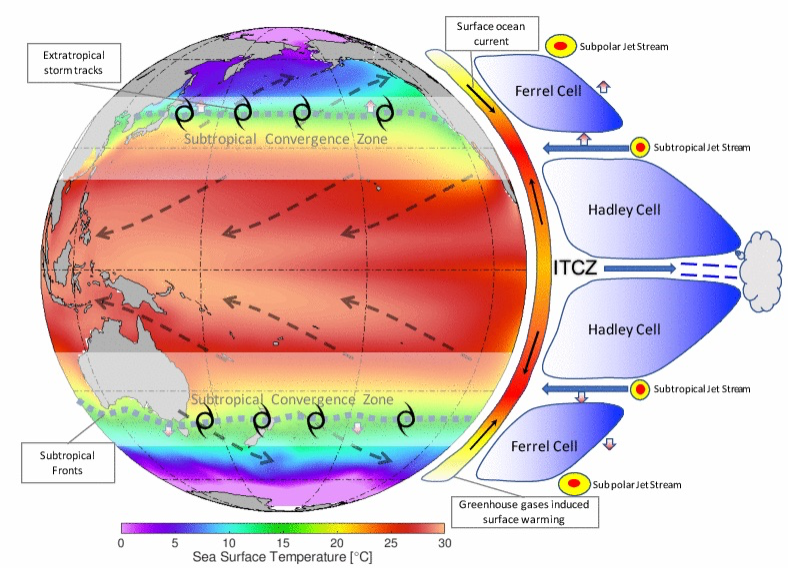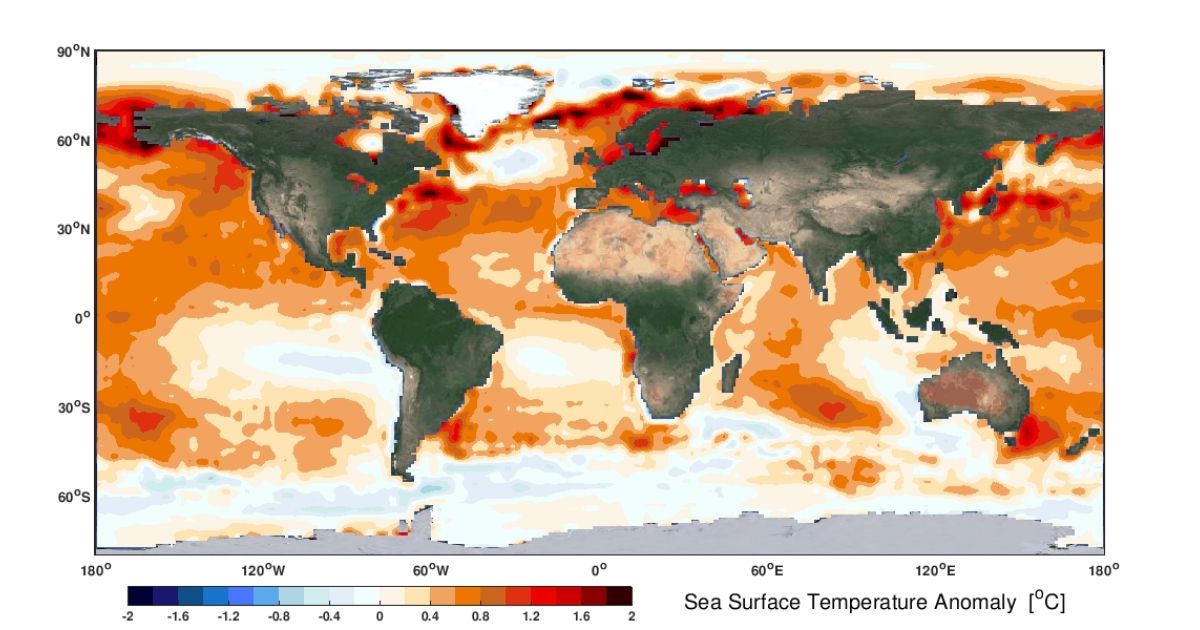Enhanced warming subtropical ocean is expanding the tropics
The severe droughts in the USA and Australia are the first sign that the tropics, and their warm temperatures, are apparently expanding in the wake of climate change. But until now, scientists have been unable to conclusively explain the reasons for this, because they were mostly focusing on atmospheric processes. Now, experts at the Alfred Wegener Institute (AWI) have solved the puzzle: the alarming expansion of the tropics is not caused by processes in the atmosphere, but quite simply by warming subtropical ocean.
Forest fires in Australia and California, droughts and water shortages in the Mediterranean -- in the last few years, events such as these have become more frequent. Researchers attribute this to the fact that the tropics, the warm region surrounding the Equator, appear to be expanding. And that leads to the affected areas becoming hotter and drier. According to the official definition, the tropics extend across the Equator between the latitudes of 23 degrees North and 23 degrees South. The central area is humid, with a great deal of precipitation, while the marginal regions in the north and south are hot and dry. As a result of climate change, however, for some time now the dry regions have been expanding northwards in the Northern Hemisphere -- as far as Southern California -- and southwards in the Southern Hemisphere.
 Schematic diagram explaining the mechanism of tropical expansion. The shading indicates the sea surface temperature, the black dashed arrows illustrate the near surface winds, the white patches are the subtropical convergence zones, and the thick gray dashed lines represent the subtropical fronts. The deep tropical heating maintains the rising branch of the Hadley circulation, namely, the ITCZ. The upper airflow losses buoyancy when it is cooled by radiative cooling, generating the sinking branch of the Hadley circulation near the subtropics. Under the forcing of trade and westerly winds, the subtropical ocean is a zone of convergence of the surface water. Therefore, greenhouse gas‐induced radiative forcing produces more warming over the subtropical convergence zone. Such warming expand the tropical warm water zones, and pushes the midlatitude meridional temperature gradient and associated storm tracks, jet streams, and descending branch of Hadley circulation toward higher latitudes. (Photo: Alfred-Wegener-Institut/ Hu Yang)
Schematic diagram explaining the mechanism of tropical expansion. The shading indicates the sea surface temperature, the black dashed arrows illustrate the near surface winds, the white patches are the subtropical convergence zones, and the thick gray dashed lines represent the subtropical fronts. The deep tropical heating maintains the rising branch of the Hadley circulation, namely, the ITCZ. The upper airflow losses buoyancy when it is cooled by radiative cooling, generating the sinking branch of the Hadley circulation near the subtropics. Under the forcing of trade and westerly winds, the subtropical ocean is a zone of convergence of the surface water. Therefore, greenhouse gas‐induced radiative forcing produces more warming over the subtropical convergence zone. Such warming expand the tropical warm water zones, and pushes the midlatitude meridional temperature gradient and associated storm tracks, jet streams, and descending branch of Hadley circulation toward higher latitudes. (Photo: Alfred-Wegener-Institut/ Hu Yang)
But up to now, climate researchers have had a problem. They couldn't conclusively explain this obvious expansion of the tropics using their climate models. The models simply didn't show the magnitude and the regional characteristic of the observed expansion. A team working with the physicists Hu Yang and Gerrit Lohmann at the Alfred Wegner Institute, Helmholtz Centre for Polar and Marine Research in Bremerhaven (AWI) has now discovered the likely cause. As the AWI experts report in the Journal of Geophysical Research Atmospheres, the reason for the expansion appears to be an altered warming of the ocean. To date, experts assumed that processes in the atmosphere played a major role -- for instance a change in the ozone concentration or the aerosols. It was also thought possible that the natural climate fluctuations that occur every few decades were responsible for the expansion of the tropics. For many years researchers had been looking in the wrong place, so to speak.
"Our simulations show that an enhanced warming over the subtropical ocean in both the Northern and Southern Hemispheres are the main drivers," says Hu Yang, the study's lead author. These subtropical warming patterns are generated by the dynamic of subtropical ocean gyres, measuring several hundreds of kilometres in diameter, which rotate slowly. These currents are especially well-known in the Pacific, because the majority of floating marine litter is concentrated in them. "Because the currents in the region bring together the surface warming water masses particularly intensely, it's easier for the subtropical ocean surface to accumulate warmth than in other regions -- and the same applies to plastic," says Lohmann. As a result of this warming of the subtropical ocean, the tropical warm ocean regions are expanding. According to his calculations, this phenomenon is the catalyst for the tropics expanding to the north and south. "Previous researchers had been taking an overly complicated approach to the problem, and assumed it was due to complex changes in the atmosphere. In reality, it's due to a relatively simple mechanism involving ocean currents."
What led the experts to explore this avenue: data on ocean gyres that they happened to come across five years ago -- data on ocean temperatures and satellite-based data, freely available on databases. Both sources indicated that the gyres were becoming warmer and more powerful. "That's what led us to believe that they might be a decisive factor in the expansion of the tropics," explains Hu Yang.
The AWI experts were right: their findings perfectly correspond to actual observations and the latest field data on tropical expansion. Just like in reality, their climate model shows that the tropics are now stretching farther to the north and south alike. In the Southern Hemisphere, the effect is even more pronounced, because the ocean takes up more of the overall area there than in the Northern Hemisphere.
Yet when it comes to the question of whether the droughts in Australia, California and the Mediterranean are due to the expansion of the tropics, Gerrit Lohmann can't give a definitive answer. "When talking about climate change, it's always difficult to quantify the respective parameters with absolute certainty," he says. "However, we can safely assume that the ocean currents and expansion of the tropics make droughts and hurricanes more likely to occur."
By Alfred Wegener Institute, Helmholtz Centre for Polar and Marine Research
Journal Reference:
Hu Yang, Gerrit Lohmann, Jian Lu, Evan J. Gowan, Xiaoxu Shi, Jiping Liu, Qiang Wang. Tropical Expansion Driven by Poleward Advancing Midlatitude Meridional Temperature Gradients. Journal of Geophysical Research: Atmospheres, 2020; 125 (16) DOI: 10.1029/2020JD033158



